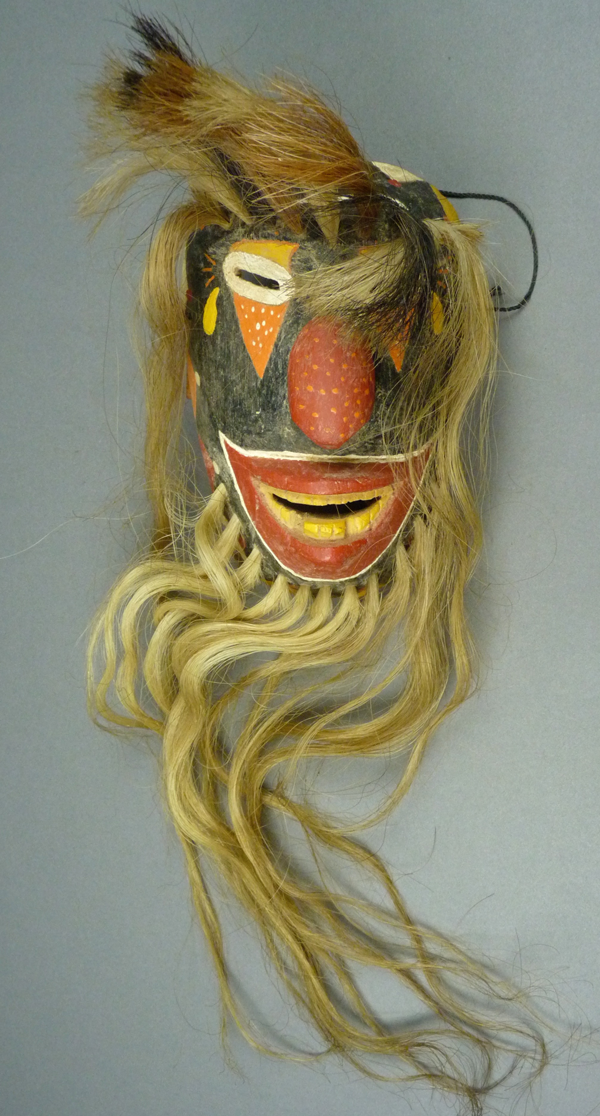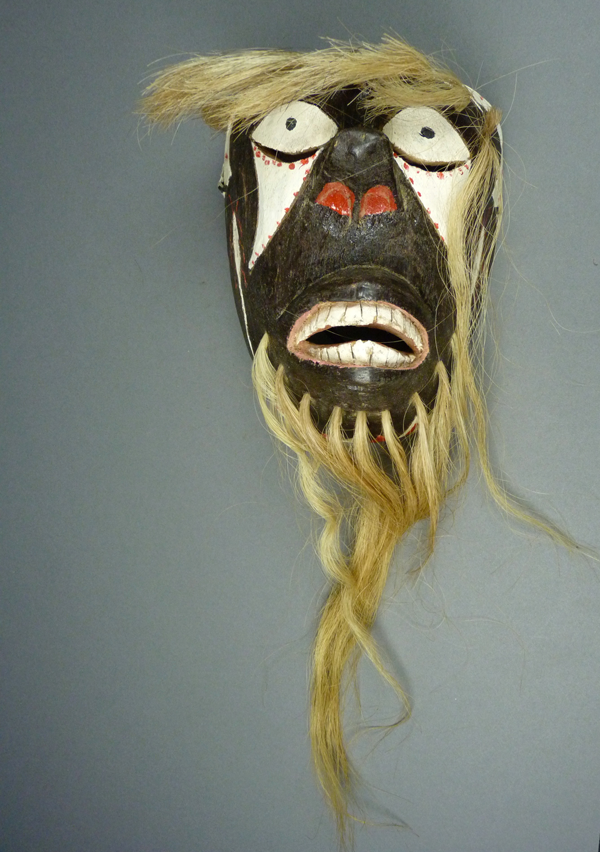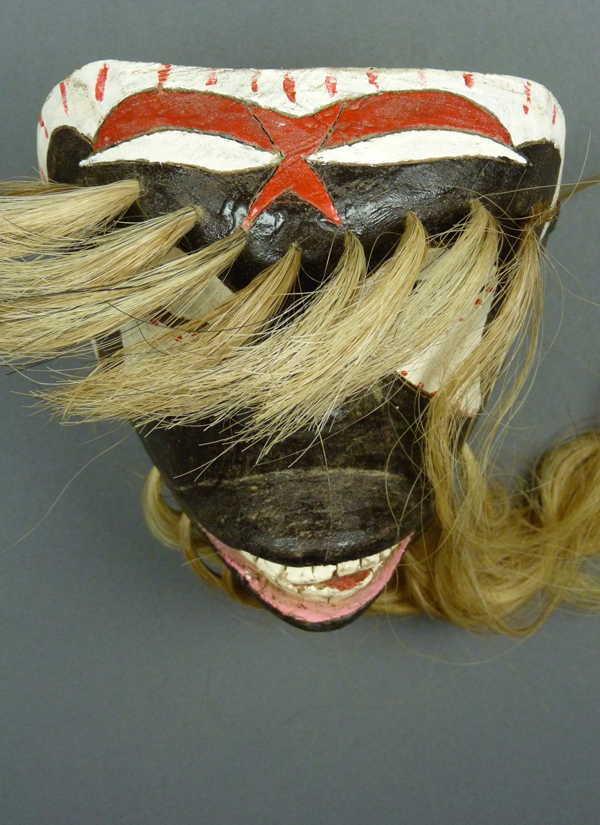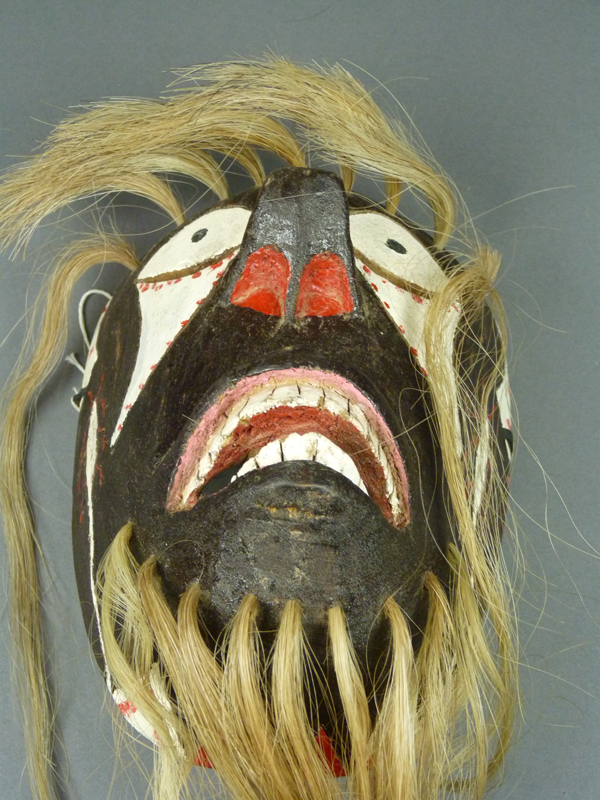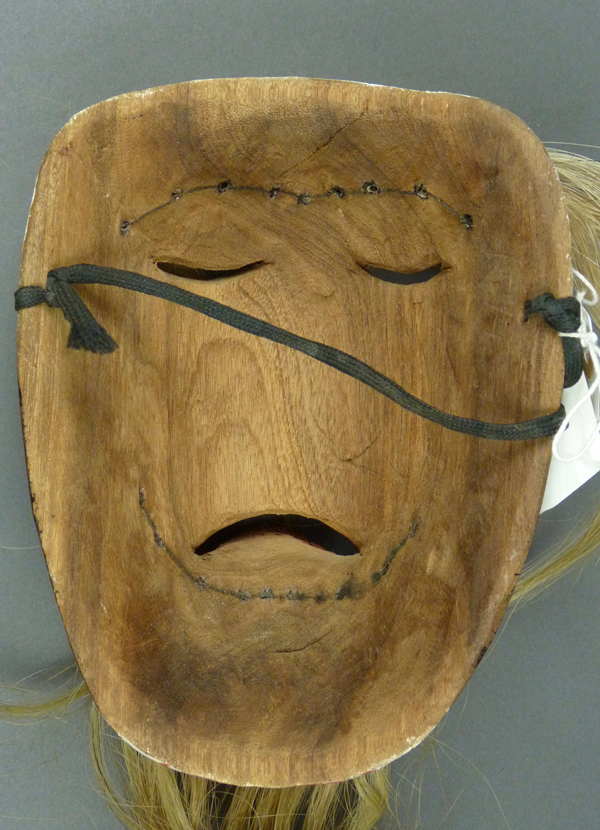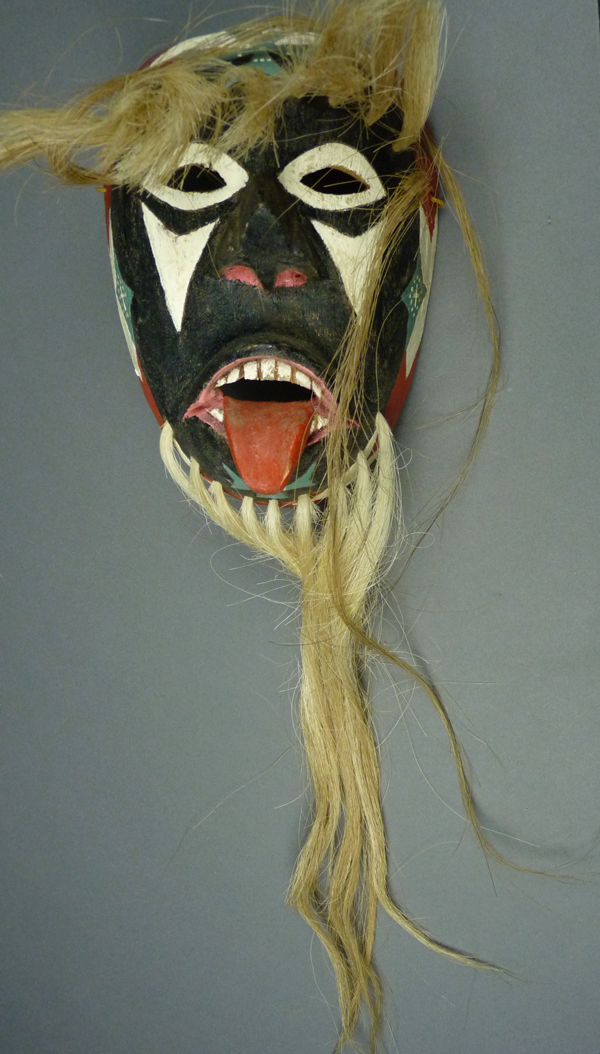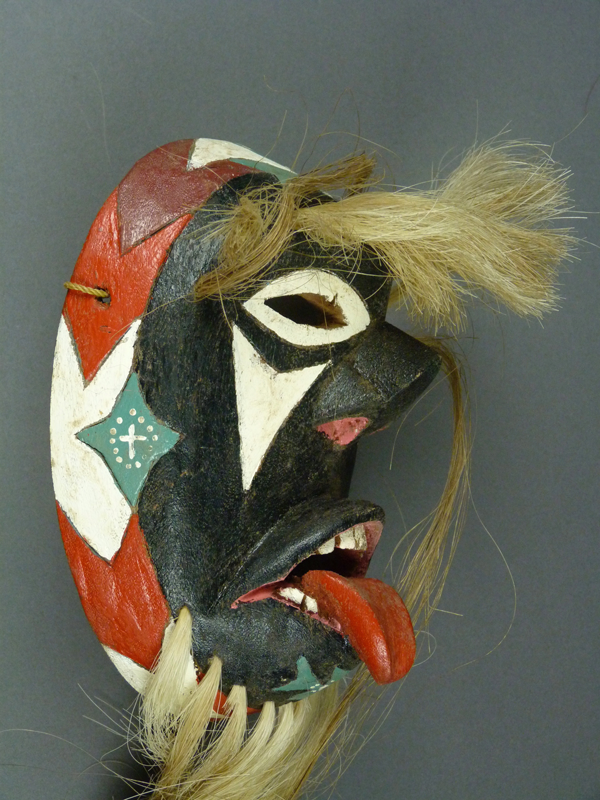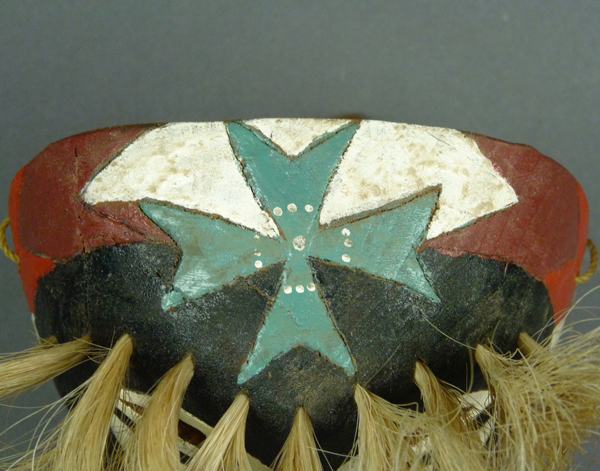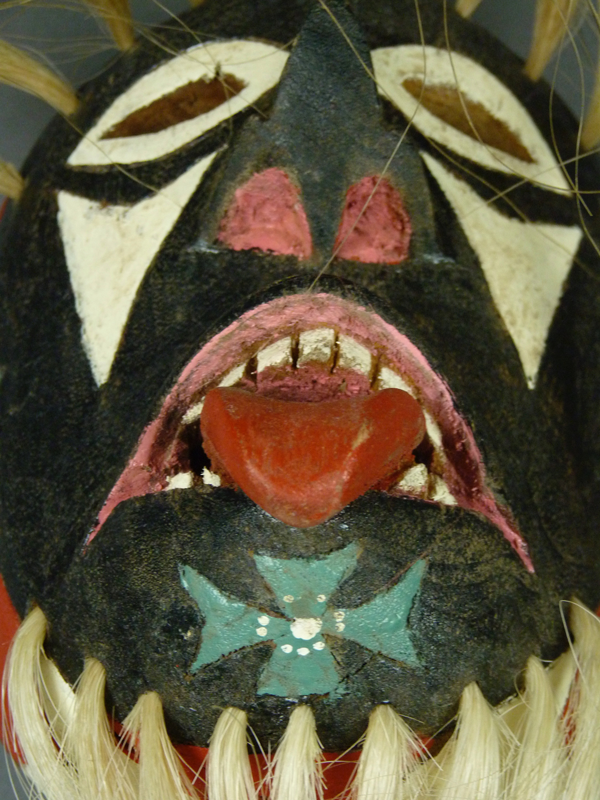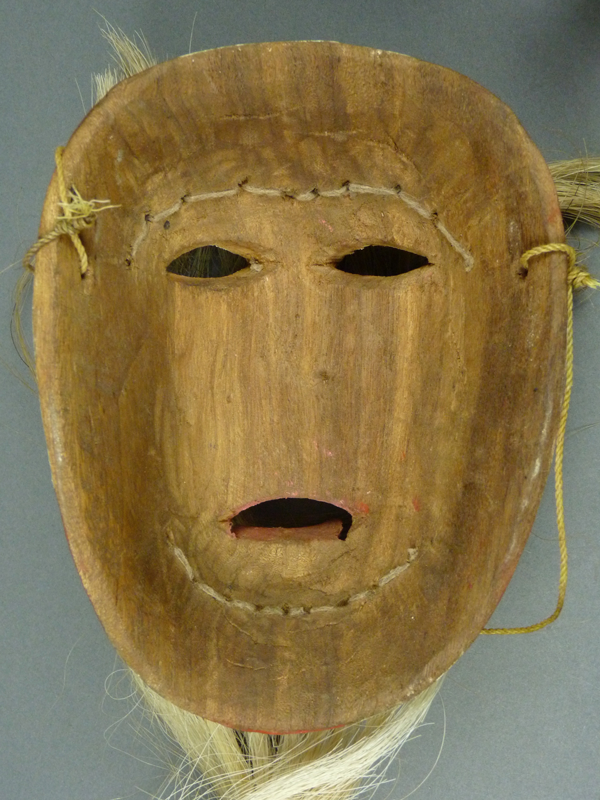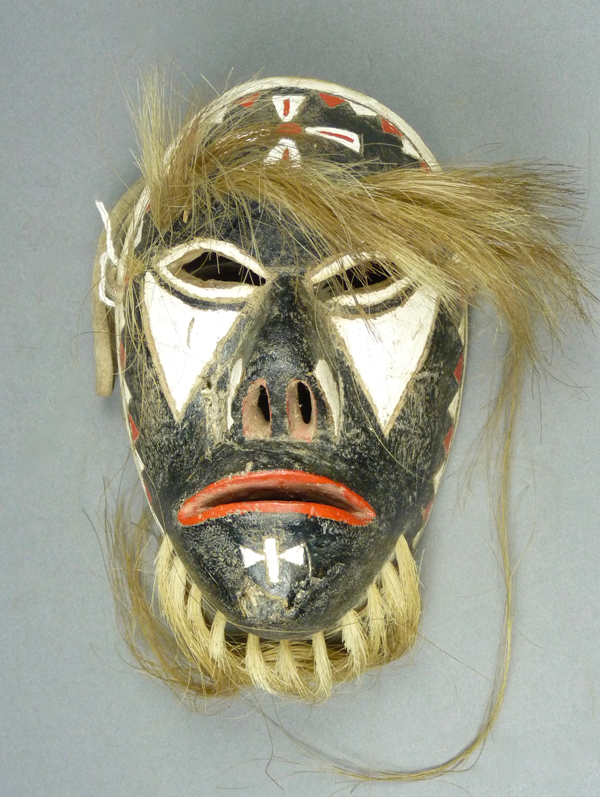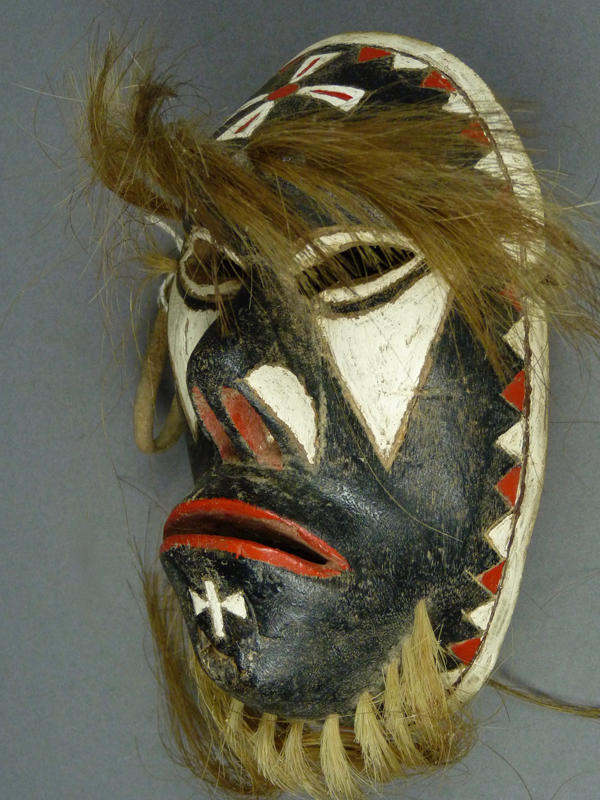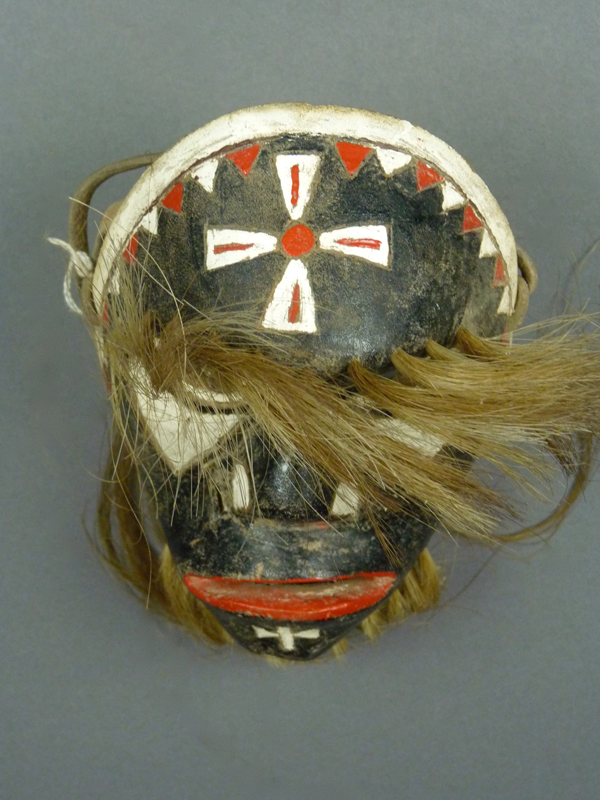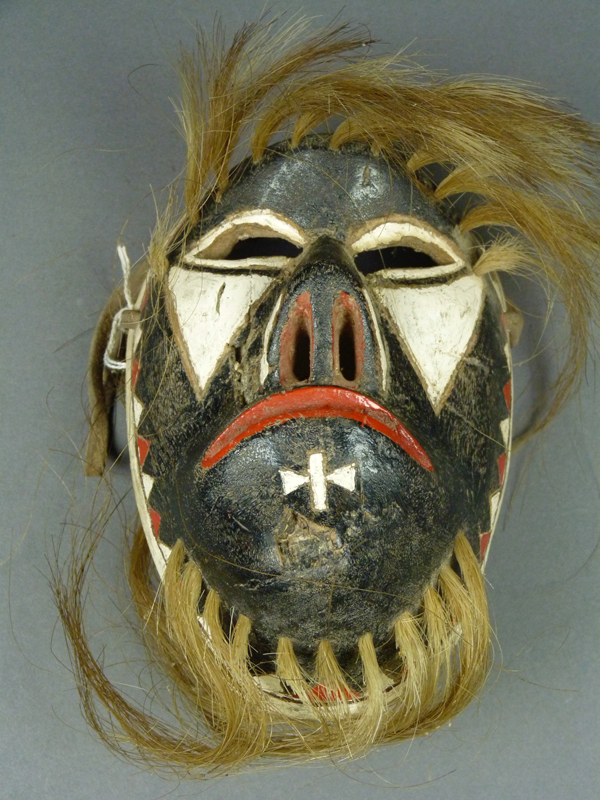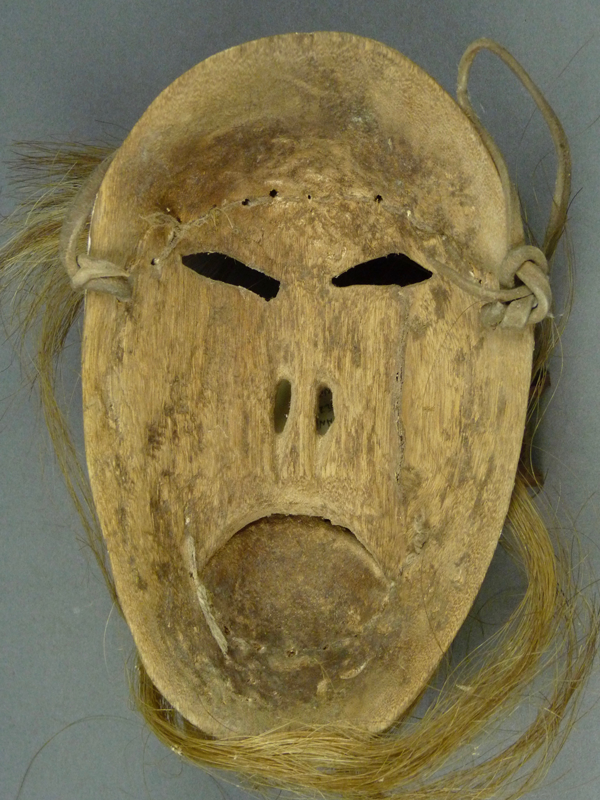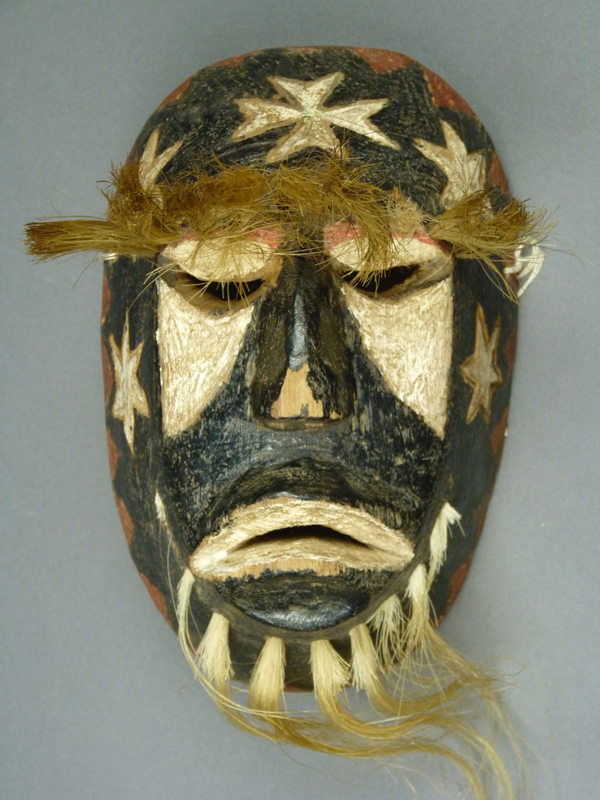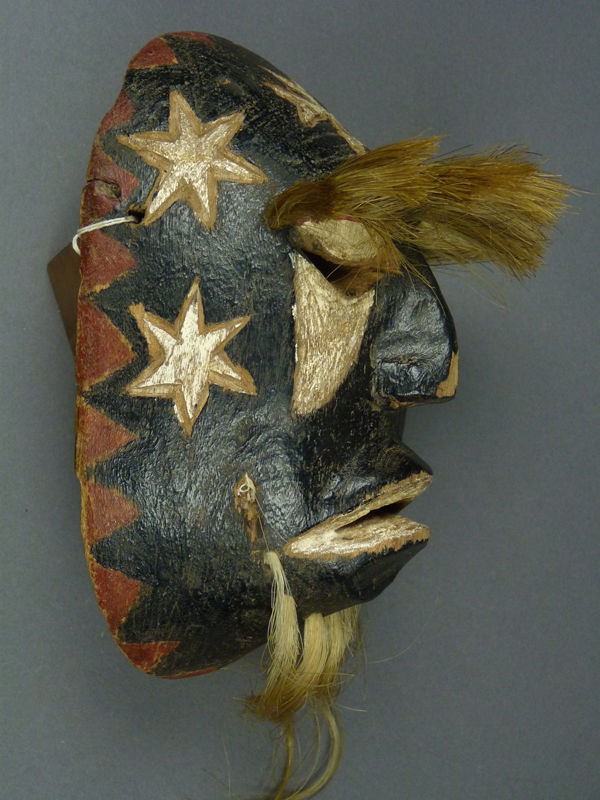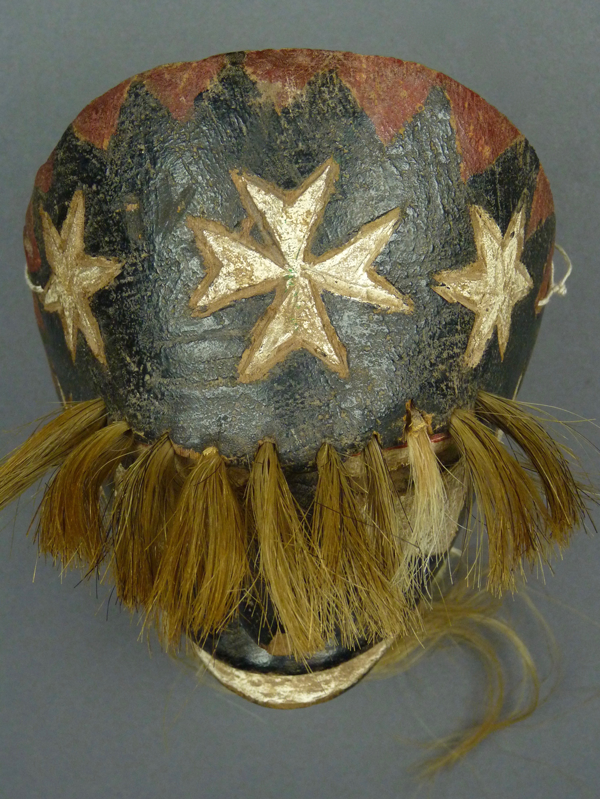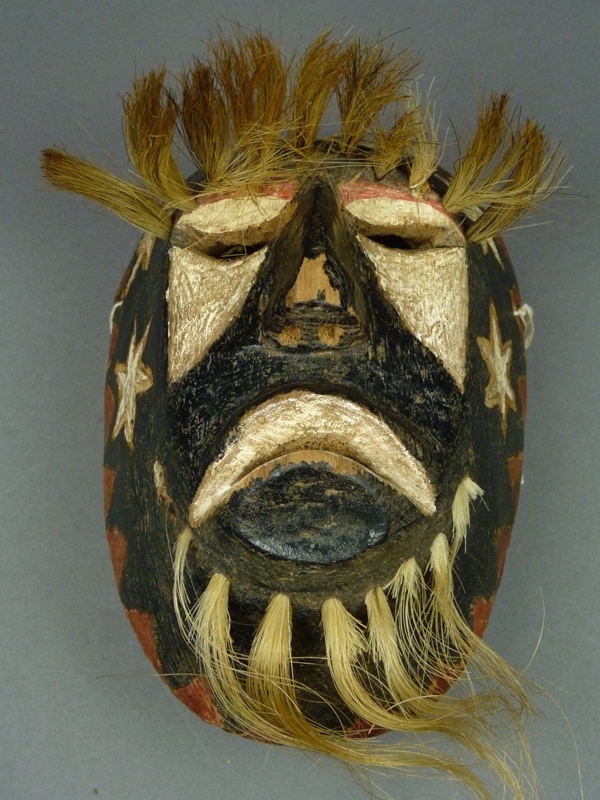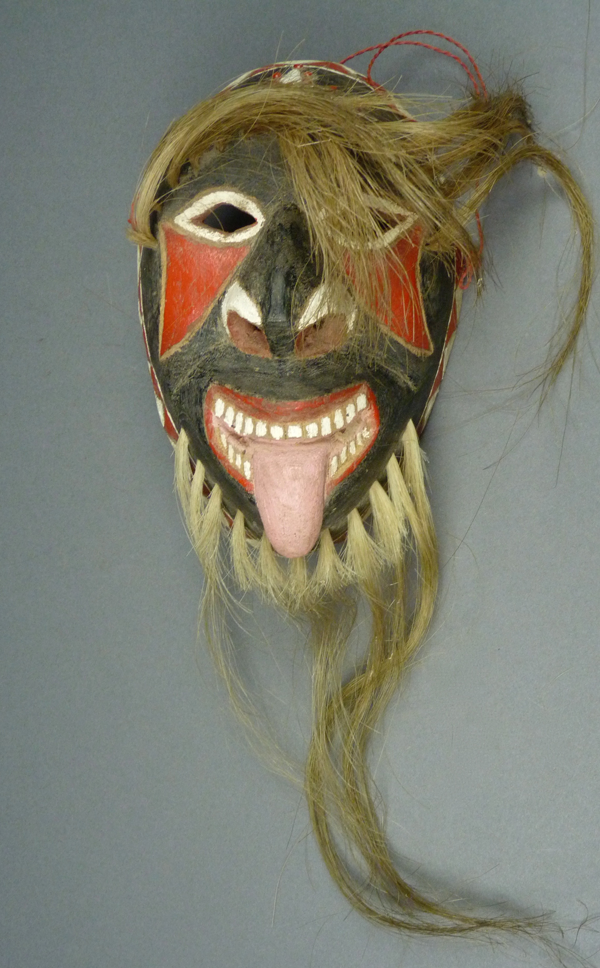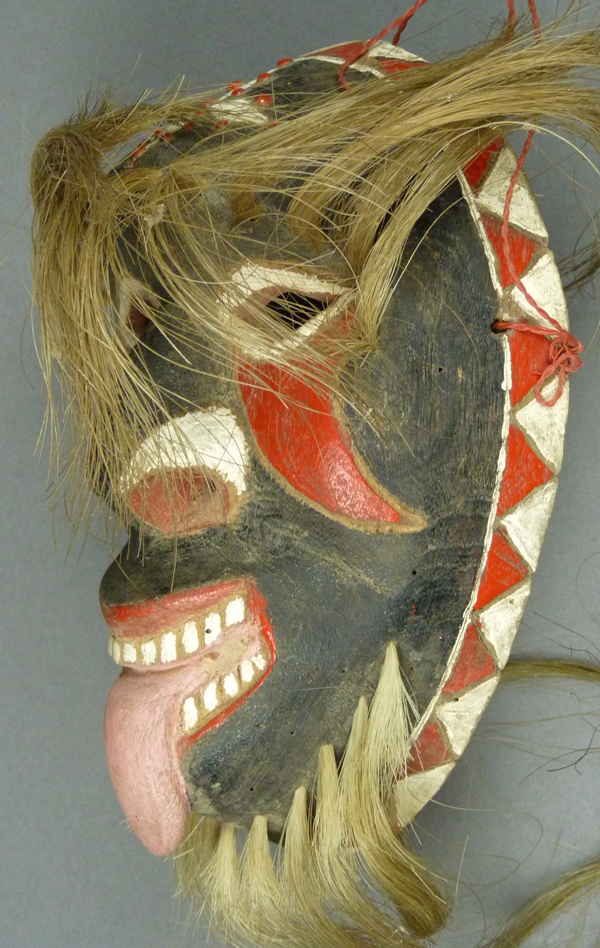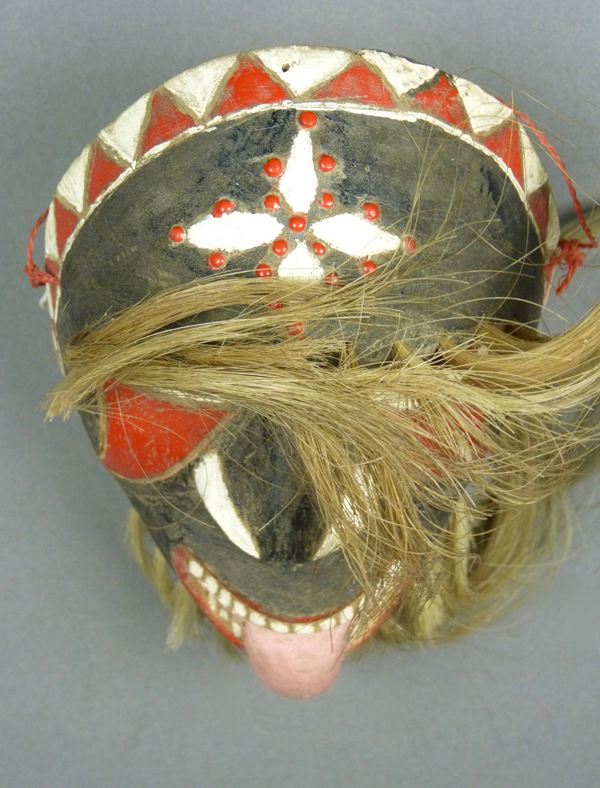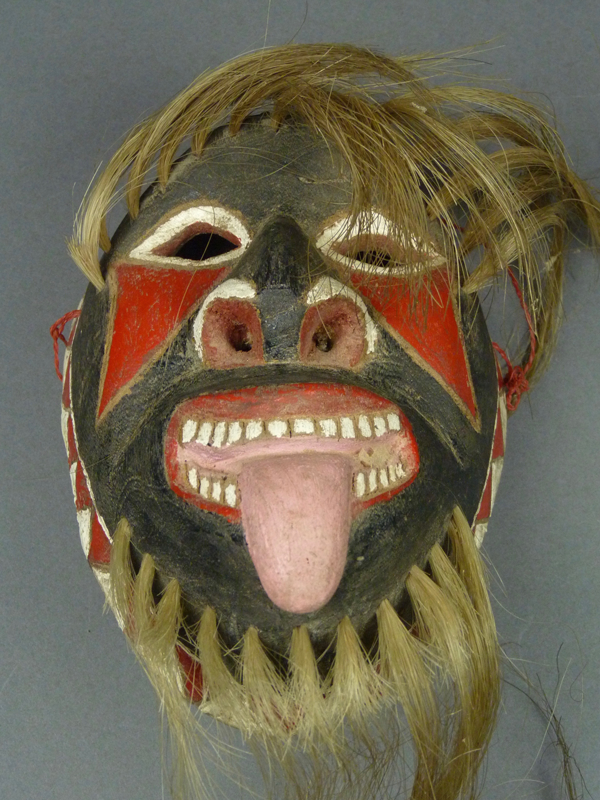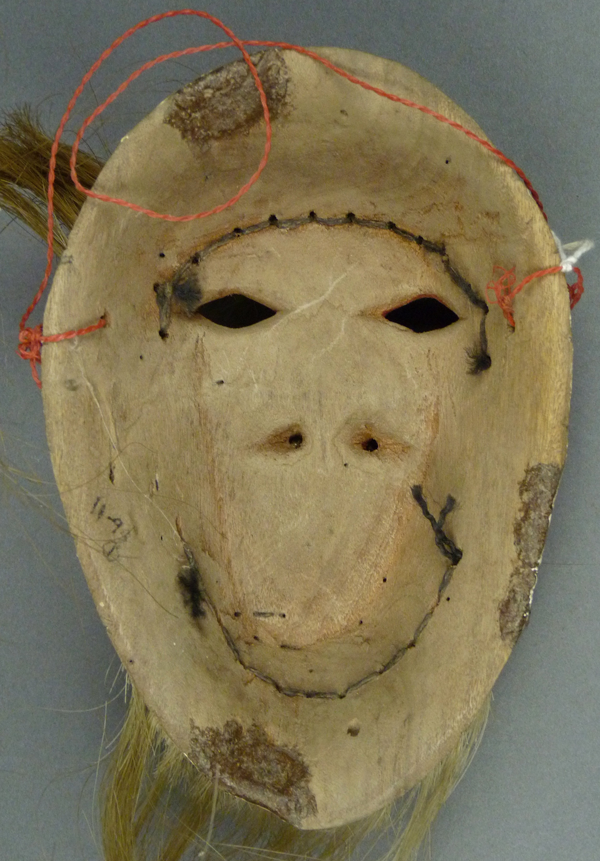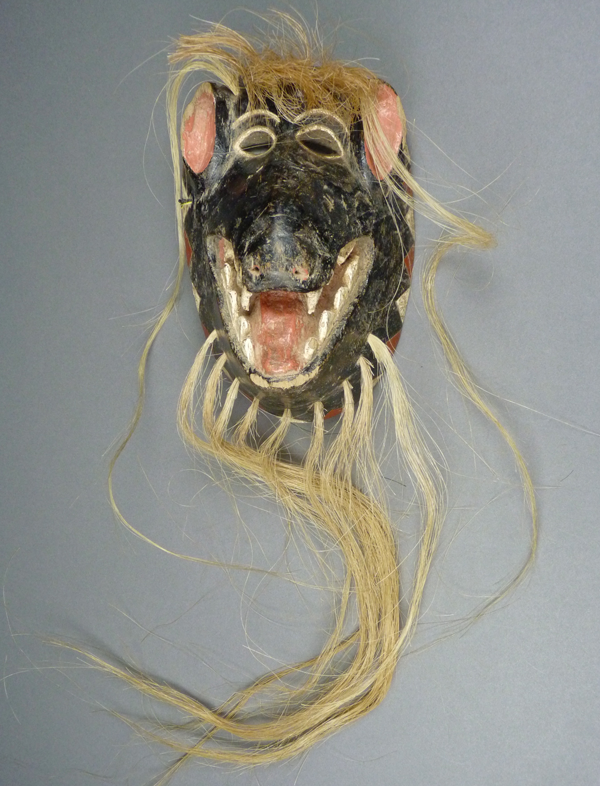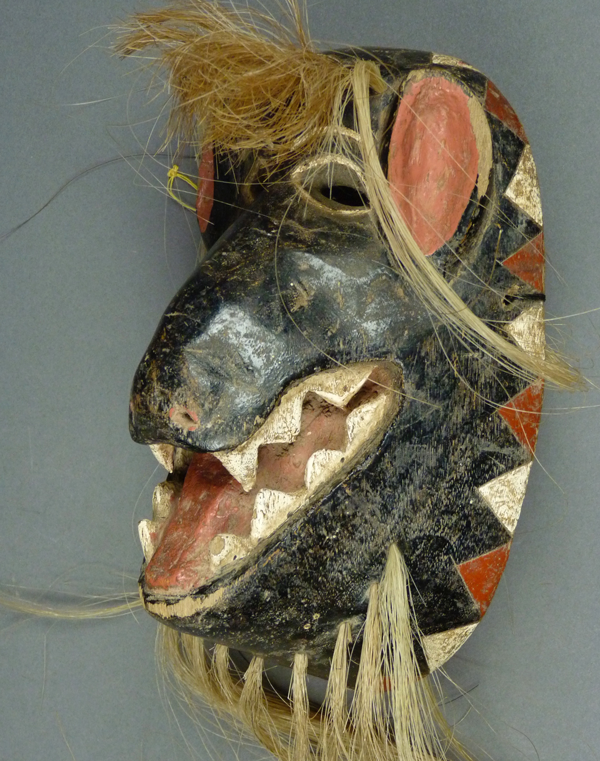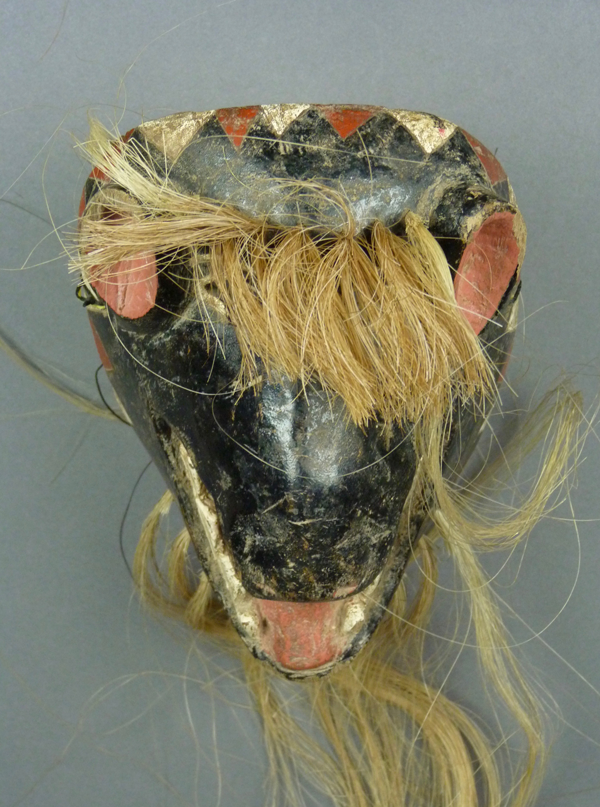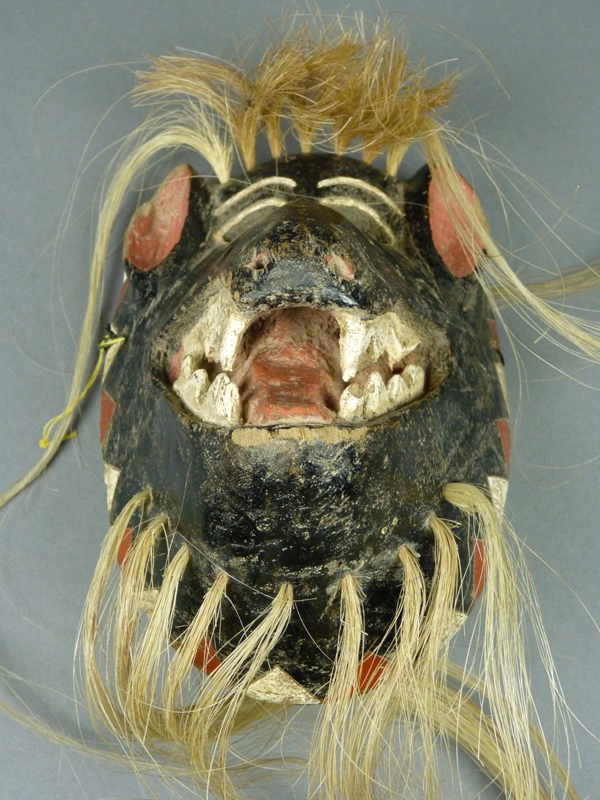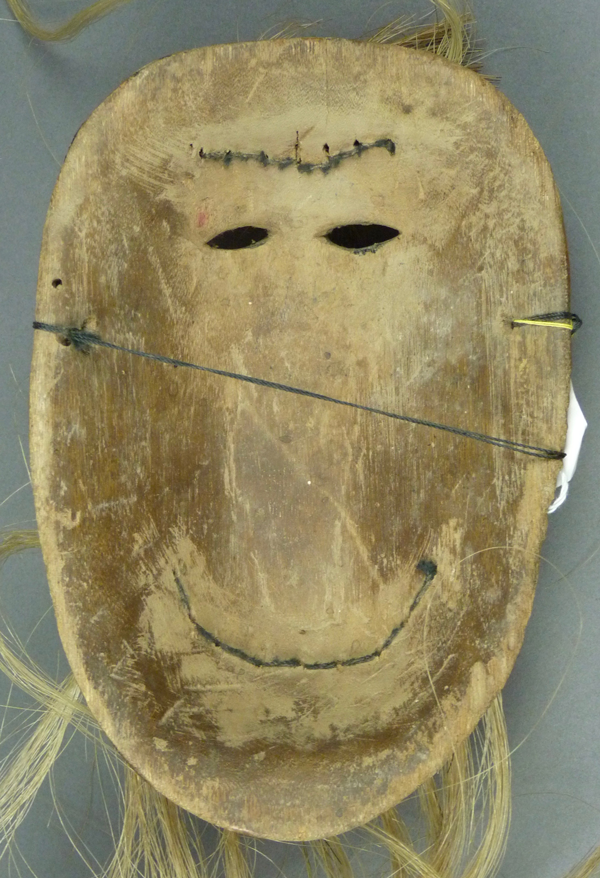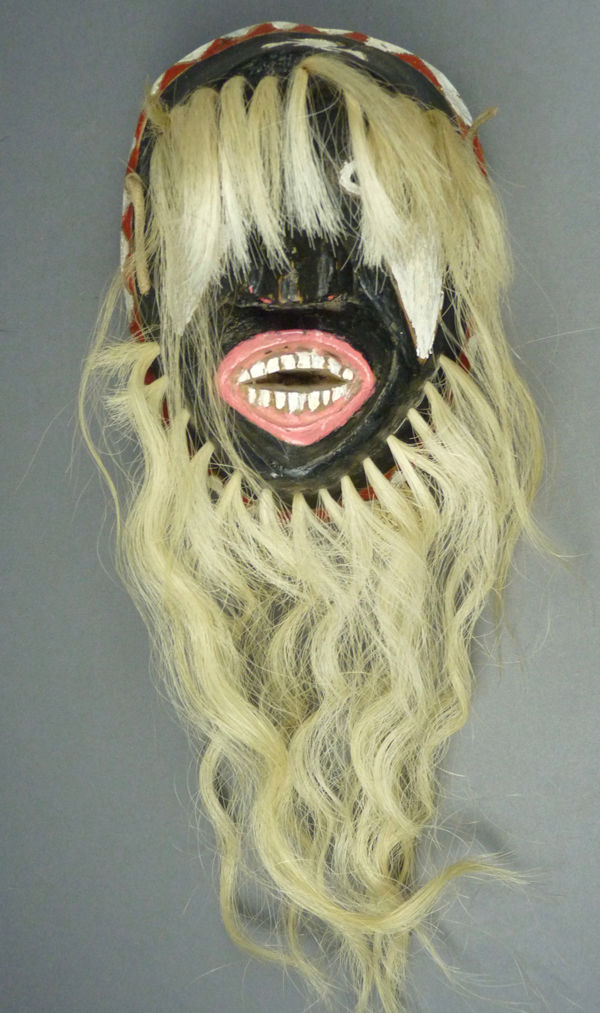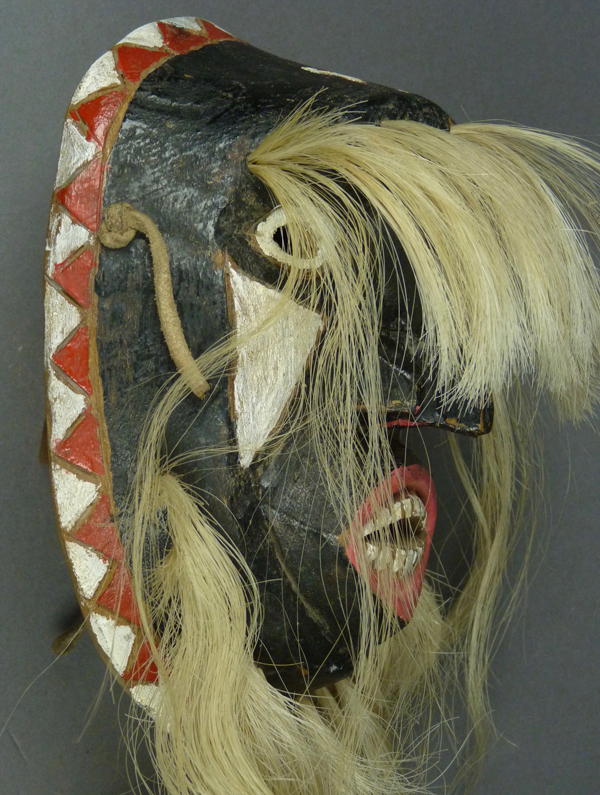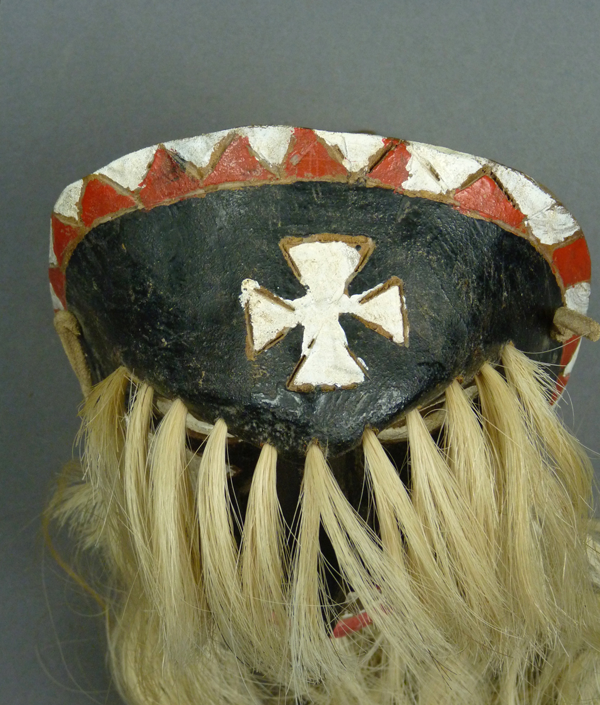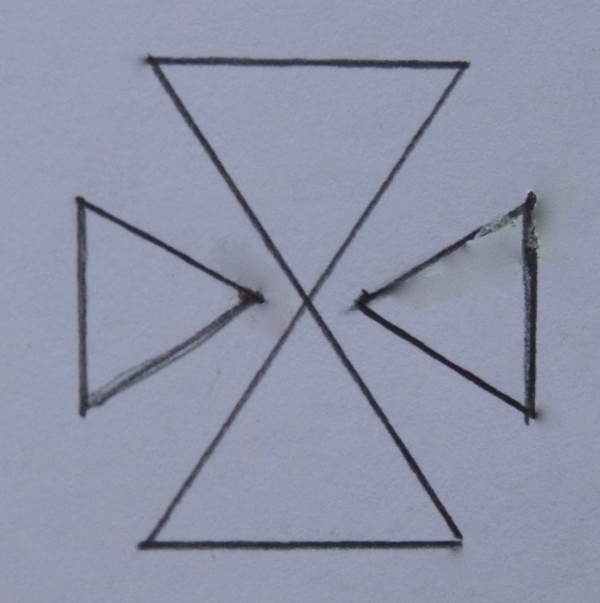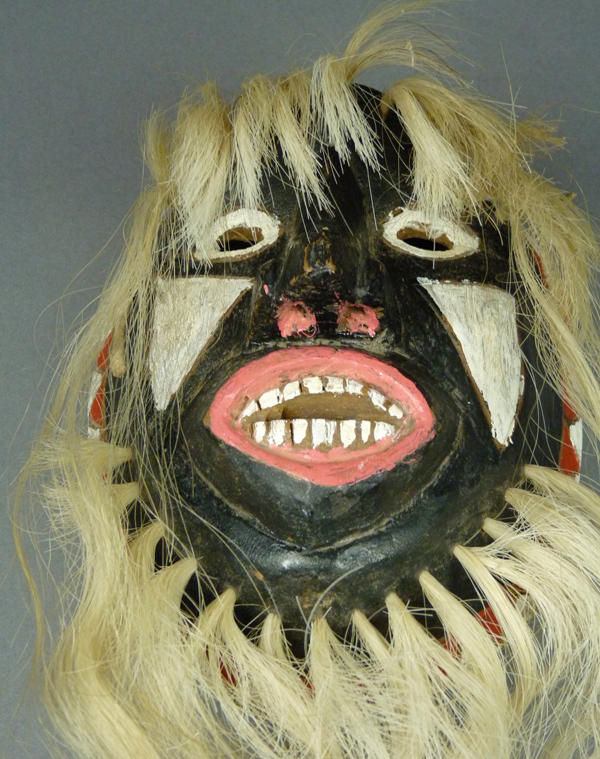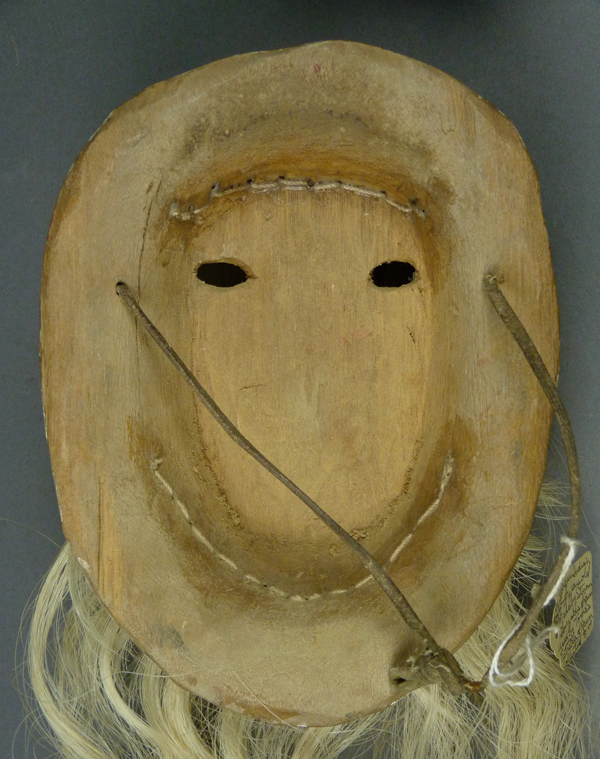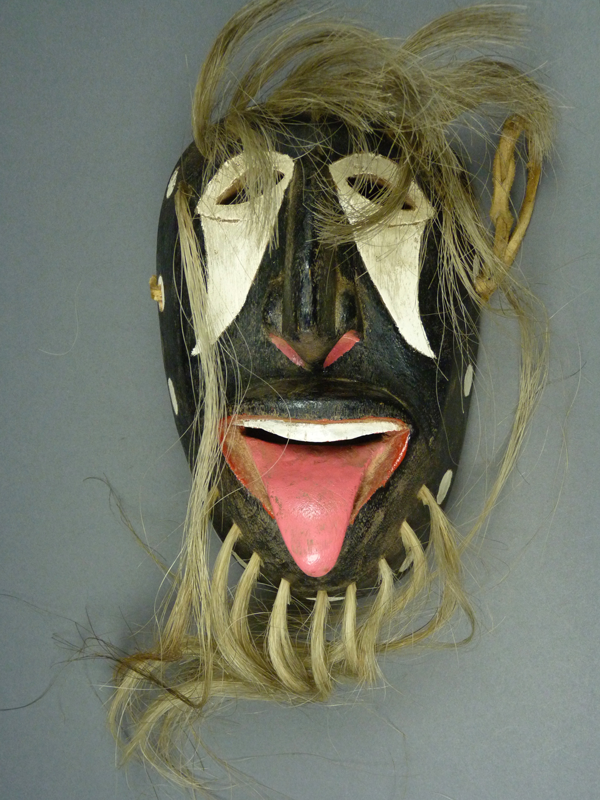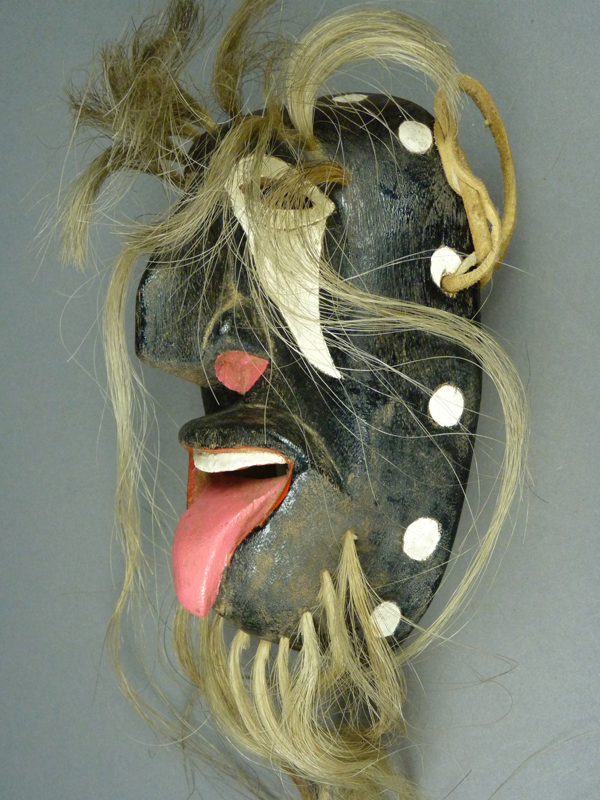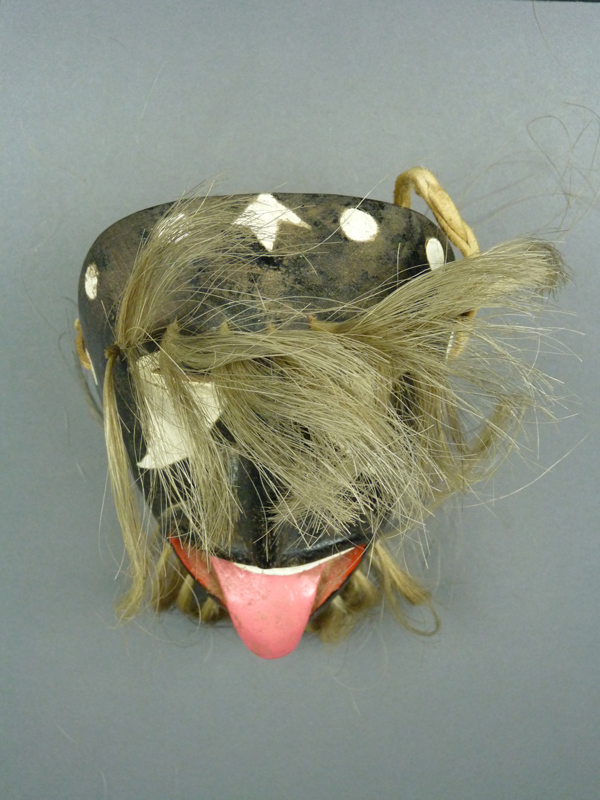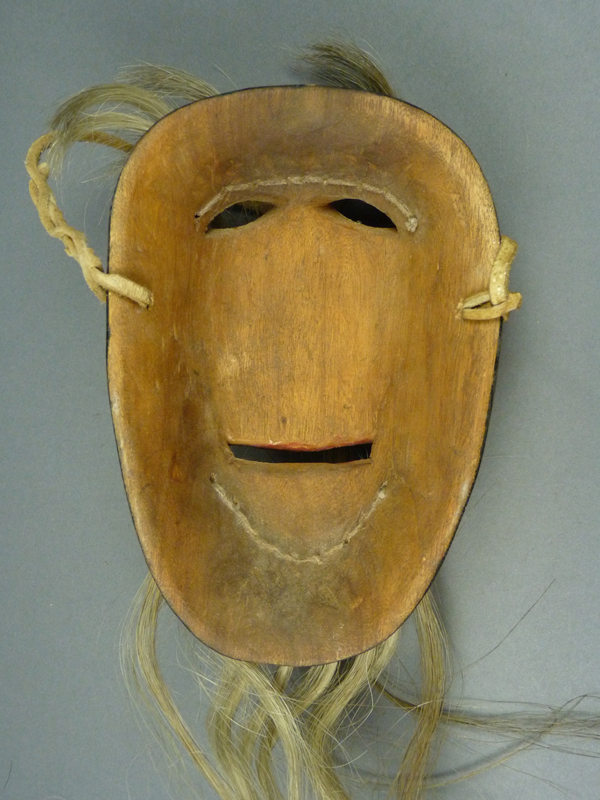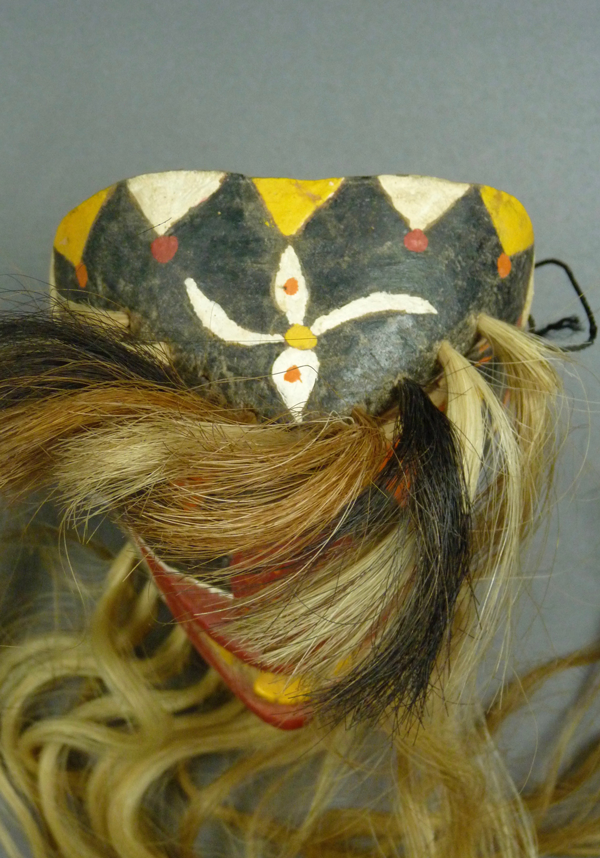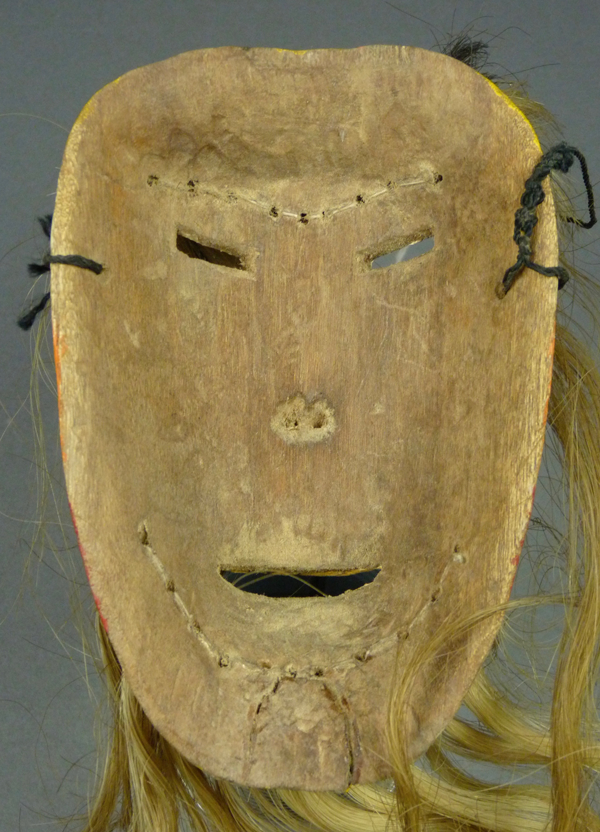In the last two months we have examined masks by four members of the Rodríguez family—brothers Rodrigo Rodríguez Muñoz and Jesús Rodríguez Muñoz, their father Preciliano Rodríguez Cupis, and their uncle Conrado Rodríguez Cupis, who is the brother of Preciliano. Based on stylistic details, my friend Tom Kolaz and I have noticed many masks which were undoubtedly carved by one of the four, although erroneously attributed to other carvers (some in and others out of the family). It is evidently difficult, even for Rodríguez family members, to decide which one of these artists made a particular mask. I sometimes can only offer my best guess. My friend Tom Kolaz even wonders whether some of these masks were the result of a group effort. Today I will show several of these masks that seem particularly difficult to assign to a single carver. For example, here is a photo of the final mask in today’s post, a Payaso (clown), to whet your appetite.
These attempted attributions rest on logical assumptions that may or may not be true. When these assumptions generate apparent contradictions, then doubts creep in about whether such assumptions always hold. Here are some of these troublesome assumptions, with comments:
1. These carvers made it a point to develop separate styles. In general, this is what one does observe throughout Mexico in general, among the Yaquis in particular, and among the members of the Rodríguez family. But the latter carvers also appear prone to share and exchange ideas, blurring their differences.
2. These carvers tended to use a consistent style over time. You many have noticed that this was probably true to a point, yet there was a tendency for a particular design feature to either change abruptly or to morph gradually from one style to another over time. There is an experimental quality to their work, of the sort that we find in many great artists (e.g. Picasso, Braque, Arp, …). It is useful to keep this in mind, that although many Mexican mask makers are craftsmen who supply a fairly consistent product, others are more appropriately understood as gifted artists.
3. When Rodríguez sellers identify a mask as the work of a family member, these attributions are more likely to be correct, in comparison to their attributions about carvers outside of their family. This is a necessary assumption if we hope to assemble sufficient observations to recognize trends, but it is essentially untestable! Furthermore, these relatives not only attribute a mask by one Rodríguez to another, but they also pin Rodríguez masks on outsiders. It is ironic that the made for sale masks may provide our most reliable benchmarks; that is why I have included them, when the danced examples are so much more impressive or satisfying.
I will begin with a pair of masks with identical turned up noses, a feature which would suggest that they were carved by the same hand, but the details suggest the involvement of more than one of these carvers. Here is the first, identified as the work of Felipe Álvarez when it was collected by Barney and Mahina Drees Burns(B/M 191). I associate this eye style with Preciliano, but I have seen it on a canine mask by Jesús. The scalloped rim makes one think of Jesús, and the forehead cross reminds me of either of the two. The backs of this mask and the next do resemble those of Jesús rather than those of Preciliano. The teeth are more refined than those usually carved by Jesús, and suggest Conrado or Preciliano. If I had to choose, I would pick Jesús as the probable carver, but not with any sense of certainty.
The turned up nose is distinctive, while the scalloped rim design is undoubtedly familiar for those of you who have have been following this discussion over the last two months. There is an inscribed insect on both cheeks.
This wonderful hybrid forehead cross, which is tightly integrated with the rim design, blends elements from crosses favored by several Rodríguez carvers—most notably Preciliano and Jesús.
The nostrils are carefully carved, and in the style of Preciliano or Conrado.
These teeth, in combination with a flat palate, look like those of Preciliano.
However, this broad back is typical of Jesús. There is good staining from use.
Here is the second of the pair of masks with turned up noses. This one was collected by Barney and Mahina in about 2000 as the work of an anonymous carver (B/M 842/836). It has obvious Rodríguez features. The triangles under the eyes, for example, are in the style of Conrado.
Here is that turned up nose again. The rim design is somewhat generic, but with elements favored by this family of carvers. The morning star is a favorite symbol on masks by Jesús.
The forehead and chin crosses are favored by Conrado and Preciliano, while Jesús often omits both crosses.
Like the previous mask, this forehead cross is integrated into the rim design, something that I associate with Preciliano (see October 17, 2016 post). Note the sloppy repaint.
The nostrils were less carefully carved, but resemble those of Preciliano and Conrado.
This back could have been carved by Jesús or some of the others. There is staining from moderate use.
I admired the next mask for months before I decided that it had to be a Rodriguez mask, and probably by Conrado or Preciliano. Since including it here, and editing, I have concluded that it was most likely carved by Preciliano. In retrospect, I don’t know why it took me so long to see this. Barney and Mahina estimated its date of carving to about 1990, and they were told that the carver was Ramon Jiron Ramírez (B/M 480/472). This is such a handsome and carefully carved older mask.
The rim design, carved with such care, is classic for the Rodríguez carvers. The design of the eyes is particularly typical for Conrado, while the associated triangles under the eyes and the open nostrils look a lot like those on several Preciliano masks, such as B/M 118 in an earlier post.
Although the nose is unusually tilted for a Rodríguez mask, it is less extreme than those on the last two masks. It is painted in the manner of Preciliano and Conrado; the more I looked at this nose, the more I saw Preciliano’s hand. I particularly admire the frowning mouth and the subtle hollow spot on the chin. The chin cross, although not exactly the same, is an echo of the chin cross of mirror fragments on an apparent Conrado mask (B/M 158) in my post of October 10, 2016, and that mask also has a frowning mouth.
The forehead cross was carved in a very formal style, but the sloppy paint and the even sloppier red painted lines tend to obscure this. Also note another characteristic that one finds on some Rodríguez masks, particularly those of Preciliano, the careful coordination of the forehead cross and the rim design.
These generously carved nostrils of triangular shape are elaborate for Conrado; if he provides air passages through the nostrils, he tends to do so with small drilled holes, and very often even these are absent. Preciliano also often omits this feature, but when he does create a nasal air passage, he carves a larger irregular opening. Such nostrils can be seen on another mask attributed to Preciliano (B/M 451/442) in my post of 10/24/2016.
This is a relatively old and heavily used mask, judging from the back. It has an original rawhide strap. In conclusion, I now think this is probably a mask by Preciliano.
Having included that mask, I will add another that is quite similar, but with fewer identifying clues. It came without any attribution or dates (B/M 826/823). It is now in my collection. One can only examine the design details and compare these to known examples. This leads to the identification of one obvious feature, the forehead cross. By now you may be able to interpret this as indicative of the hand of either Preciliano or Conrado. The second observation is that this mask has a very similar shape to the one that preceded it, which appears to have been carved by Preciliano. The third observation is that this eye design resembles those of Preciliano, although it is more dramatically carved that those we have seen on his other masks. I conclude that this is a Preciliano mask from an earlier time, when he was carving in a less formal style.
The four six-pointed stars around the upper half of the rim are unfamiliar to me, although Manuel Centella Escalante made six pointed stars that were composed of six diamond shaped segments; these stars are not segmented and they have sharper points. Similarities between these two carvers should not surprise us, as they were contemporaries who lived and worked in the same town- Potam. I will show those Centella masks with stars in a later post. The nose is nondescript, so it is of little help to our inquiry. The triangles under the eyes are consistent with those we have seen on other Preciliano masks.
There is a hollow spot on the chin, and this lies under a frowning mouth, just as one observes on the mask above this one. The rim design is generic and the triangles are not defined by inscribed lines. These are wonderful stars.
I believe that this is an older mask than many of these by Preciliano that we have seen.
I really like that chin. If the red designs above the eyes were triangular, that would push us in the direction of Centella, but these designs don’t resemble Centella’s.
The back of this mask is certainly within the range of Preciliano’s style. The staining of the rim suggests that this mask was danced for many years.
The next of these mystery masks could have been carved by Conrado Rodríguez Cupis or Preciliano Rodríguez Cupis. There is also the possibility that it was carved by Inez “Cheto” Álvarez. Barney and Mahina purchased this mask in 1993 as the work of an unidentified carver (B/L 236/233). My friend Tom Kolaz was inclined to consider Cheto, while I am thinking that Conrado or maybe Preciliano are the most likely culprits.
The large nose is in the style of Conrado, while the broad curving triangles under the eyes make one think of Preciliano. The diamond-shaped openings for the eyes are unusual, and I don’t know who favored that design detail. The teeth look like those of Conrado or Preciliano, while the extended tongue does make one think of Cheto Álvarez, but also of Jesús (9/26/2016 post).
The forehead cross of four petals suggests Preciliano or Jesús.
The nose makes on think of Conrado. This generic rim design has been used by all three of the suspects.
The back looks like those of Preciliano, even including the shaped nostril openings. I feel nearly certain that this is a Rodríguez mask, and I am betting on Preciliano.
The fifth mask has a rim design that reminds one of masks of the Rodriguez family. It was collected by Barney and Mahina in 2004 as the work of Esteban González, to whom several masks were attributed by the Rodríguez family, but no one of them resembled another (B/M 224). I am tempted to postulate a Rodríguez carver. This is a brilliant mask.
Looking at the frontal photo, the eyes could be the work of Conrado, while the shape, the teeth, and the absence of a forehead cross suggest Jesús.
There is no forehead cross. Although the rim design is generic, it is often rendered this crisply by members of the Rodríguez family.
The mouth, tongue, and teeth are dramatically carved but there is no air passage, not even through the nostrils.
There are jagged teeth.
The back is delicately carved, making one think of Preciliano’s hand; it is not so different from the back of the unusual canine mask in my 10/24/2016 post that had been attributed to that carver. In the end, I don’t know who carved this mask, but I really like it.
The next mask is another that was attributed to Esteban González, but this time by none other than Inez “Cheto” Álvarez, when Barney and Mahina bought the mask in 1999 (B/M 391/383). The nose on this mask made Tom Kolaz think of several other carvers rather than Esteban, most notably of Conrado.
The eyes, the mouth, and the teeth look like those of Conrado and Preciliano.
If this mask had a forehead cross made up of four triangles with their points together, then that would be most characteristic of Manuel Centella Escalante. However, this actually appears to be a cross composed of a vertical hourglass shape that is flanked by two triangular arms, in which case we are looking at a cross like one by Conrado in last week’s post. The sloppy paint makes this difficult to see.
I have drawn my impression of the inscribed lines that are hidden by the sloppy paint.
The mask lacks any chin cross.
This chin view emphasizes a mouth typical of Conrado and Preciliano.
This back looks like those of Cheto Álvarez. Still, I think that the evidence favors Conrado.
Compared to the last mask, the next has a more obvious resemblance to masks by the Rodríguez carvers. However, Barney and Mahina purchased this mask in 2003 as the work of Tiofilo Chiber of Huiviris, Sonora (B/M 465/457).
The eyes and nose particularly resemble those features on the masks of Conrado, and he could also have carved those upper teeth. However, the long curving triangles under the eyes are most typical of Preciliano.
The forehead cross and the rim design are unusual and unfamiliar, I can’t tell whether the circles of the rim design were framed by inscribed lines, and the three-pronged “cross” may also have been painted freehand. Perhaps these elements were added later by a dancer; we have seen obvious Rodríguez masks that were virtually undecorated.
Such a tongue could have been made by several of the Rodríguez carvers.
The view from below certainly reveals a Rodríguez nose, probably the work of Conrado.
The back is well carved in the Rodríguez manner.
At the time of purchase, Barney and Mahina were told that this Payaso (clown) Pascola mask had been carved by Rodrigo Rodríguez Muñoz. But as we shall see, the eyes are in the style of Conrado Rodríguez Cupis and the nose looks something like those of Preciliano or Conrado. Furthermore, although this mask bears a passing resemblance to several clowns by Jesús, the noses on those masks are quite different from this one.
The forehead cross is well within the style of Preciliano, and markedly different from those typical of Rodrigo.
Looking at the nose from below, one thinks again of both Preciliano and Conrado.
The irregular teeth remind me of Conrado.
The back most resembles some by Preciliano, but Conrado comes in as a close second.
Obviously one is not always able to resolve the ambiguity about who carved a particular mask. I have lingered so long on the masks of the Rodríguez family because I find them to be brilliant, but now it is time to move on. Next week we will begin to look at the work of a carver who is easier to recognize, Camilo Álvarez Buitimea, the step-son of Inez “Cheto” Álvarez.

